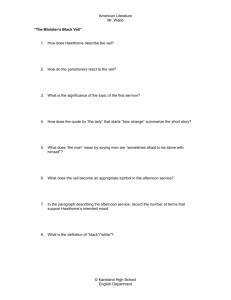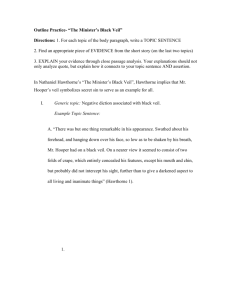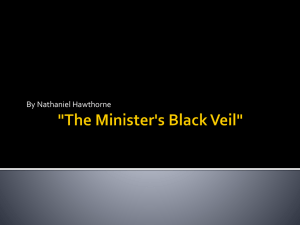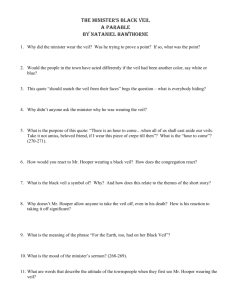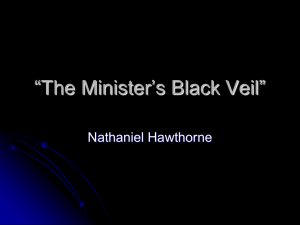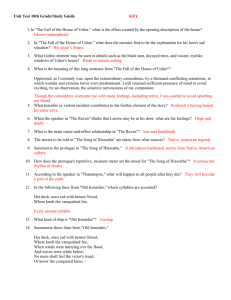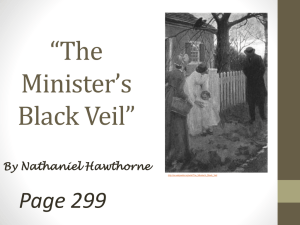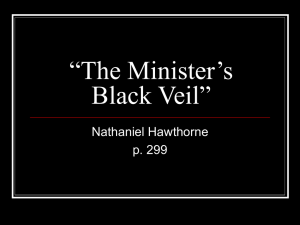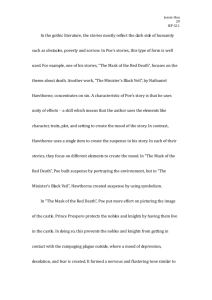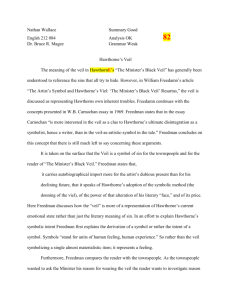The Minister*s Black Veil
advertisement
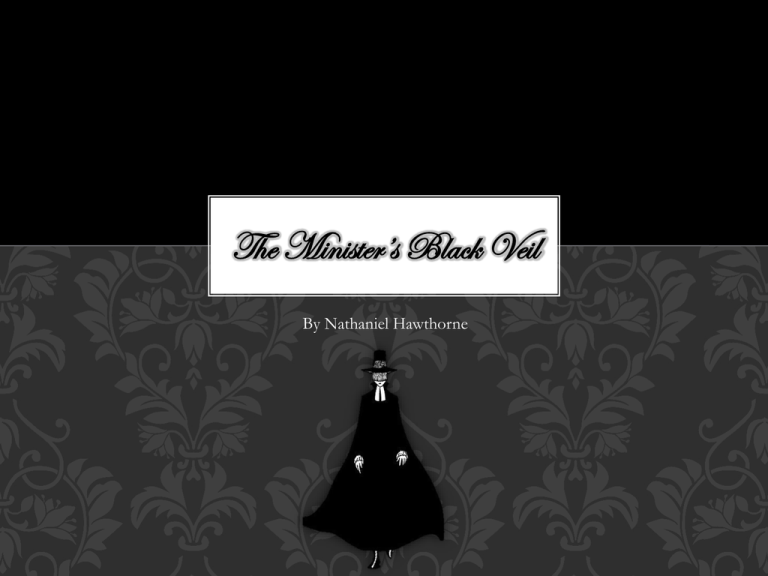
The Minister’s Black Veil By Nathaniel Hawthorne SILLY QUIZ #5 How did the Minister’s parishioners react to the veil? OBJECTIVES To develop vocabulary and word identification skills To use a variety of reading strategies to comprehend a short story To increase knowledge of other cultures and to connect common elements across cultures To express and support responses to the text To analyze literary elements To increase knowledge of the rules of grammar and language NATHANIEL HAWTHORNE Born in Salem, Massachusetts. Descended from a prominent Puritan family. Believed that evil was a dominant force in the world. His fiction expresses a gloomy vision of human affairs. One of Hawthorne’s ancestors was a Puritan judge who played a key role in the Salem witchcraft trials. Both Hawthorne’s character and focus as a writer were shaped by a sense of inherited guilt. He was haunted by the intolerance and cruelty of his ancestors. He was not a Puritan and was born 112 years after the Salem witchcraft trials. Master of symbolism and allegory. Wrote many stories that included symbolism, but never outright said what the symbols stood for, preferring to leave it to interpretation. He wrote throughout his life. He presented The Minister’s Black Veil as a parable. LITERARY DEVICES Symbolism: a group of words or sentences that use symbols to represent a thought or an idea. Allegory: a text that could be interpreted to reveal a hidden meaning or a moral lesson. TEXT ANALYSIS: PARABLE Parable: a simple, usually brief, story that teaches a moral lesson. A type of Allegory, which is a story with both a literal and a symbolic meaning. In subtitling this story “A Parable,” Hawthorne indicates that the moral lesson it conveys is both important and central to the purpose of the text. THEMES Theme of ‘Estrangement’ Estrangement: (n) the fact of no longer being on friendly terms or part of a social group. CONNECTING LITERARY ELEMENTS The veil that Mr. Hooper vows never to remove is a symbol – something that has meaning in itself while also standing for something greater. To understand the message expressed, analyze the veil’s symbolic meaning. Revealed through responses of parishioners. Revealed in minister’s own deathbed explanation. Revealed through symbolic moments. Hawthorne uses both allegory and symbolism to convey the general meaning of the symbol. READING SKILL: INFERENCES Draw inferences about meaning. When message of work of fiction is conveyed indirectly through symbols, the reader must draw inferences, or conclusions. Look closely at details, descriptions, dialogue, and imagery. VOCABULARY 1. 2. 3. 4. 5. 6. 7. 8. Ambiguity Zealous Iniquity Preternatural Ostentatious Imbued Tremulous Portend 1. 2. 3. 4. 5. 6. 7. 8. Unclearness; uncertainty Eager and enthusiastic Wickedness Supernatural Loud; overdone Deeply influenced by Trembling To signify PRE-DISCUSSION Consider the masks that people wear in today’s society. Imagine that you had to wear a mask for a day that reflects something about your true identity. READING SKILLS AND TEXT ANALYSIS Symbol: lines 133-138: In this context, what could Mr. Hooper mean when he refers to “the dreadful hour that should snatch the veil from their faces”? Symbol: lines 159-166: What reaction or belief does the veil or mask generate here? Culture: lines 175-199: What motivates the parishioners to confront Mr. Hooper? What do their fears reveal about Puritan culture? Symbol: lines 200-210: Contrast the response of the minister’s fiancée to the veil with the responses of the other villagers. What might explain the difference in her response? Symbol: lines 243-266: From this passage, what can you surmise about the meaning of the veil? Does this passage help the theme of estrangement? How so? Symbol: lines 380-387: What do his comments suggest about the meaning of the veil? DISCUSSION According to the text, what is good and what is bad about the veil? How do the people react to the veil? What does that tell you about the culture of the puritans? How did the minister become estranged from his parishioners? In what ways did the veil affect the people around the minister? How could the same black veil be fine on a woman’s bonnet but “terrible” when covering the minister’s face? What does the physician mean by saying that people sometimes are afraid to be alone? What does it mean to know that Mr. Hooper has chosen to do something that may result on solitude? Notice the narrator's comments in lines 98-100 and 128-129. how sympathetic is the narrator to Mr. Hooper? Lines 266-270, why does Elizabeth leave so suddenly? Do you think that she realized something? The minster constantly preaches about confessing one’s sins to God and the people around, yet he never tells of the reason he is wearing the veil. How does this fact affect the story? DISCUSSION Critics disagree about the meaning of the veil. Edgar Allan Poe once argued that the minister wears the veil out of remorse for a secret sin involving the young woman whose funerals he attends (lines 115 – 142). Do you agree with this interpretation? If yes, what evidence supports this thesis? If no, what evidence expels this theory?
